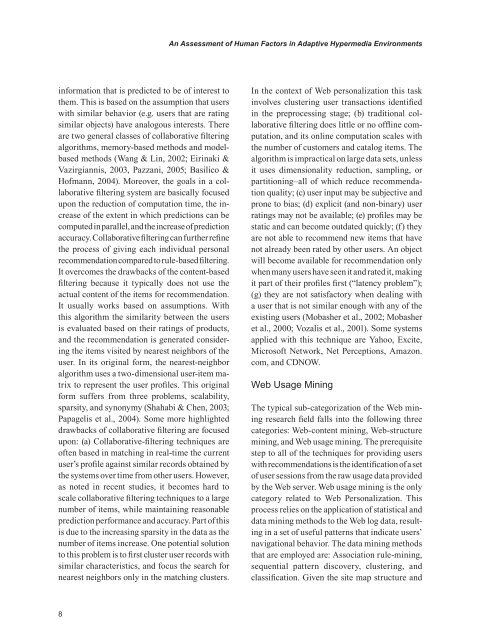(Premier Reference Source) Constantinos Mourlas, Panagiotis Germanakos, Constantinos Mourlas, Panagiotis Germanakos - INTELLIGENT USER INTERFACES_ Adaptation and Personalization Systems and Technologi
Create successful ePaper yourself
Turn your PDF publications into a flip-book with our unique Google optimized e-Paper software.
An Assessment of Human Factors in Adaptive Hypermedia Environments<br />
information that is predicted to be of interest to<br />
them. This is based on the assumption that users<br />
with similar behavior (e.g. users that are rating<br />
similar objects) have analogous interests. There<br />
are two general classes of collaborative filtering<br />
algorithms, memory-based methods <strong>and</strong> modelbased<br />
methods (Wang & Lin, 2002; Eirinaki &<br />
Vazirgiannis, 2003, Pazzani, 2005; Basilico &<br />
Hofmann, 2004). Moreover, the goals in a collaborative<br />
filtering system are basically focused<br />
upon the reduction of computation time, the increase<br />
of the extent in which predictions can be<br />
computed in parallel, <strong>and</strong> the increase of prediction<br />
accuracy. Collaborative filtering can further refine<br />
the process of giving each individual personal<br />
recommendation compared to rule-based filtering.<br />
It overcomes the drawbacks of the content-based<br />
filtering because it typically does not use the<br />
actual content of the items for recommendation.<br />
It usually works based on assumptions. With<br />
this algorithm the similarity between the users<br />
is evaluated based on their ratings of products,<br />
<strong>and</strong> the recommendation is generated considering<br />
the items visited by nearest neighbors of the<br />
user. In its original form, the nearest-neighbor<br />
algorithm uses a two-dimensional user-item matrix<br />
to represent the user profiles. This original<br />
form suffers from three problems, scalability,<br />
sparsity, <strong>and</strong> synonymy (Shahabi & Chen, 2003;<br />
Papagelis et al., 2004). Some more highlighted<br />
drawbacks of collaborative filtering are focused<br />
upon: (a) Collaborative-filtering techniques are<br />
often based in matching in real-time the current<br />
user’s profile against similar records obtained by<br />
the systems over time from other users. However,<br />
as noted in recent studies, it becomes hard to<br />
scale collaborative filtering techniques to a large<br />
number of items, while maintaining reasonable<br />
prediction performance <strong>and</strong> accuracy. Part of this<br />
is due to the increasing sparsity in the data as the<br />
number of items increase. One potential solution<br />
to this problem is to first cluster user records with<br />
similar characteristics, <strong>and</strong> focus the search for<br />
nearest neighbors only in the matching clusters.<br />
In the context of Web personalization this task<br />
involves clustering user transactions identified<br />
in the preprocessing stage; (b) traditional collaborative<br />
filtering does little or no offline computation,<br />
<strong>and</strong> its online computation scales with<br />
the number of customers <strong>and</strong> catalog items. The<br />
algorithm is impractical on large data sets, unless<br />
it uses dimensionality reduction, sampling, or<br />
partitioning–all of which reduce recommendation<br />
quality; (c) user input may be subjective <strong>and</strong><br />
prone to bias; (d) explicit (<strong>and</strong> non-binary) user<br />
ratings may not be available; (e) profiles may be<br />
static <strong>and</strong> can become outdated quickly; (f) they<br />
are not able to recommend new items that have<br />
not already been rated by other users. An object<br />
will become available for recommendation only<br />
when many users have seen it <strong>and</strong> rated it, making<br />
it part of their profiles first (“latency problem”);<br />
(g) they are not satisfactory when dealing with<br />
a user that is not similar enough with any of the<br />
existing users (Mobasher et al., 2002; Mobasher<br />
et al., 2000; Vozalis et al., 2001). Some systems<br />
applied with this technique are Yahoo, Excite,<br />
Microsoft Network, Net Perceptions, Amazon.<br />
com, <strong>and</strong> CDNOW.<br />
Web Usage Mining<br />
The typical sub-categorization of the Web mining<br />
research field falls into the following three<br />
categories: Web-content mining, Web-structure<br />
mining, <strong>and</strong> Web usage mining. The prerequisite<br />
step to all of the techniques for providing users<br />
with recommendations is the identification of a set<br />
of user sessions from the raw usage data provided<br />
by the Web server. Web usage mining is the only<br />
category related to Web <strong>Personalization</strong>. This<br />
process relies on the application of statistical <strong>and</strong><br />
data mining methods to the Web log data, resulting<br />
in a set of useful patterns that indicate users’<br />
navigational behavior. The data mining methods<br />
that are employed are: Association rule-mining,<br />
sequential pattern discovery, clustering, <strong>and</strong><br />
classification. Given the site map structure <strong>and</strong>



